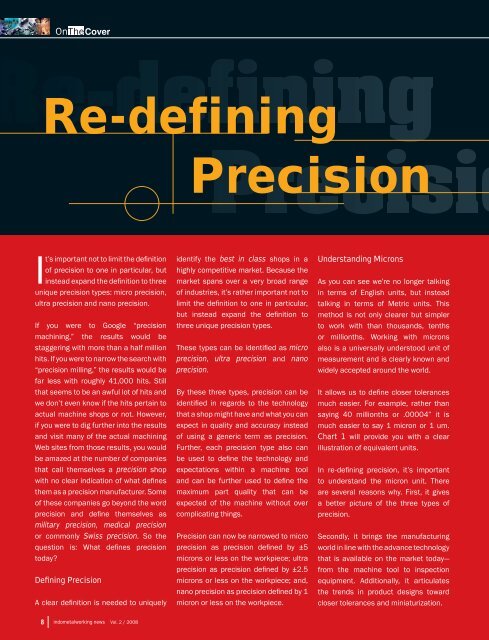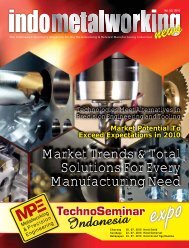High Speed Machining Precision Tooling - Indobiz.biz
High Speed Machining Precision Tooling - Indobiz.biz
High Speed Machining Precision Tooling - Indobiz.biz
You also want an ePaper? Increase the reach of your titles
YUMPU automatically turns print PDFs into web optimized ePapers that Google loves.
Re-defining<br />
<strong>Precision</strong><br />
It’s important not to limit the defi nition<br />
of precision to one in particular, but<br />
instead expand the defi nition to three<br />
unique precision types: micro precision,<br />
ultra precision and nano precision.<br />
If you were to Google “precision<br />
machining,” the results would be<br />
staggering with more than a half million<br />
hits. If you were to narrow the search with<br />
“precision milling,” the results would be<br />
far less with roughly 41,000 hits. Still<br />
that seems to be an awful lot of hits and<br />
we don’t even know if the hits pertain to<br />
actual machine shops or not. However,<br />
if you were to dig further into the results<br />
and visit many of the actual machining<br />
Web sites from those results, you would<br />
be amazed at the number of companies<br />
that call themselves a precision shop<br />
with no clear indication of what defi nes<br />
them as a precision manufacturer. Some<br />
of these companies go beyond the word<br />
precision and defi ne themselves as<br />
military precision, medical precision<br />
or commonly Swiss precision. So the<br />
question is: What defi nes precision<br />
today?<br />
Defining <strong>Precision</strong><br />
A clear defi nition is needed to uniquely<br />
identify the best in class shops in a<br />
highly competitive market. Because the<br />
market spans over a very broad range<br />
of industries, it’s rather important not to<br />
limit the defi nition to one in particular,<br />
but instead expand the defi nition to<br />
three unique precision types.<br />
These types can be identifi ed as micro<br />
precision, ultra precision and nano<br />
precision.<br />
By these three types, precision can be<br />
identifi ed in regards to the technology<br />
that a shop might have and what you can<br />
expect in quality and accuracy instead<br />
of using a generic term as precision.<br />
Further, each precision type also can<br />
be used to defi ne the technology and<br />
expectations within a machine tool<br />
and can be further used to defi ne the<br />
maximum part quality that can be<br />
expected of the machine without over<br />
complicating things.<br />
<strong>Precision</strong> can now be narrowed to micro<br />
precision as precision defi ned by ±5<br />
microns or less on the workpiece; ultra<br />
precision as precision defi ned by ±2.5<br />
microns or less on the workpiece; and,<br />
nano precision as precision defi ned by 1<br />
micron or less on the workpiece.<br />
Understanding Microns<br />
As you can see we’re no longer talking<br />
in terms of English units, but instead<br />
talking in terms of Metric units. This<br />
method is not only clearer but simpler<br />
to work with than thousands, tenths<br />
or millionths. Working with microns<br />
also is a universally understood unit of<br />
measurement and is clearly known and<br />
widely accepted around the world.<br />
It allows us to defi ne closer tolerances<br />
much easier. For example, rather than<br />
saying 40 millionths or .00004” it is<br />
much easier to say 1 micron or 1 um.<br />
Chart 1 will provide you with a clear<br />
illustration of equivalent units.<br />
In re-defi ning precision, it’s important<br />
to understand the micron unit. There<br />
are several reasons why. First, it gives<br />
a better picture of the three types of<br />
precision.<br />
Secondly, it brings the manufacturing<br />
world in line with the advance technology<br />
that is available on the market today—<br />
from the machine tool to inspection<br />
equipment. Additionally, it articulates<br />
the trends in product designs toward<br />
closer tolerances and miniaturization.<br />
8<br />
indometalworking news Vol. 2 / 2008




